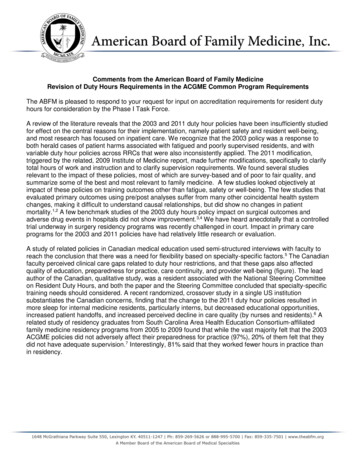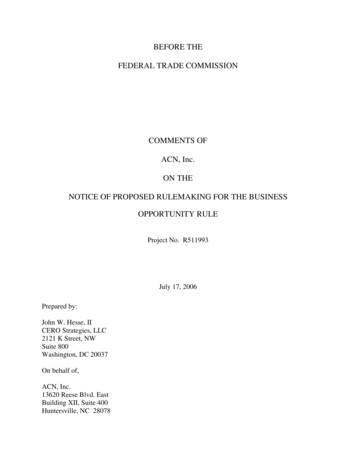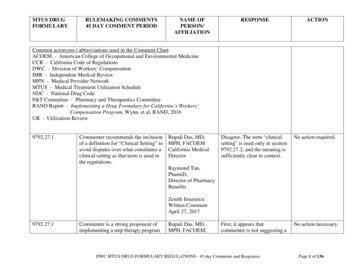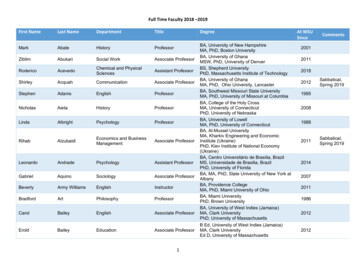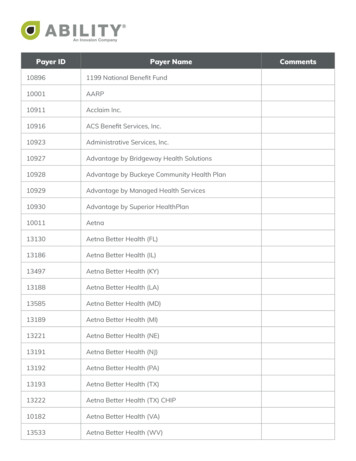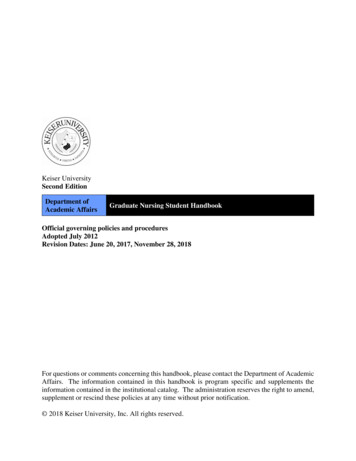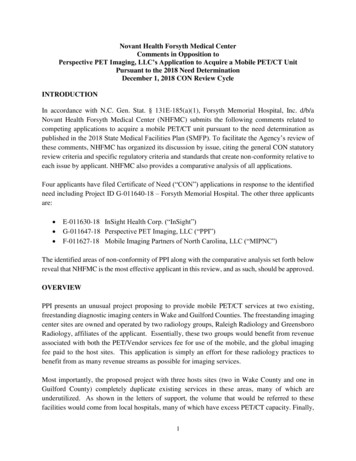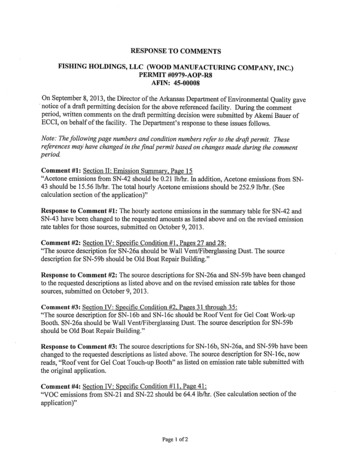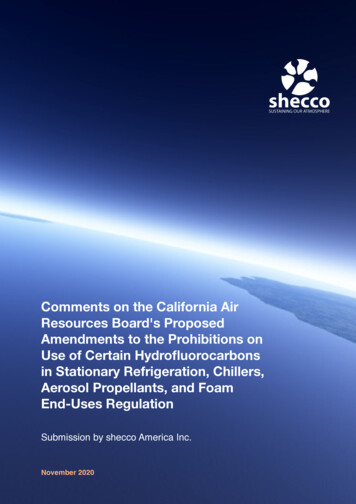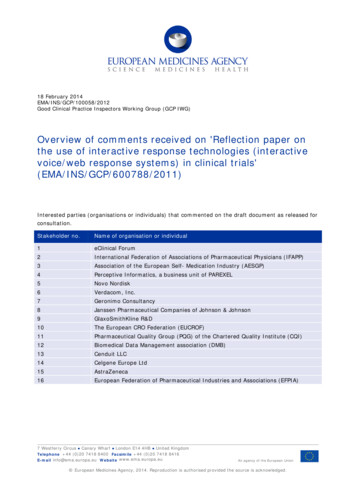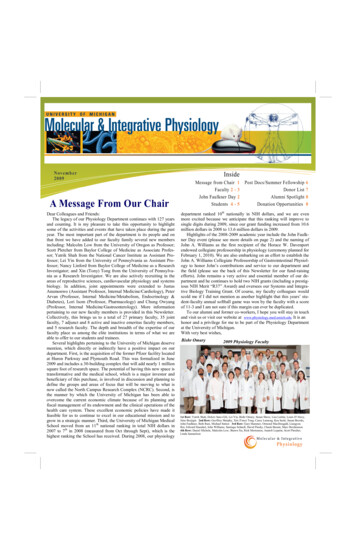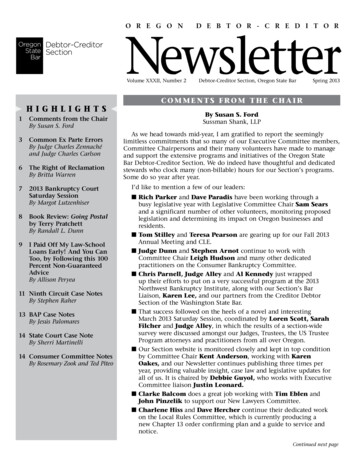
Transcription
O R E G O ND E B T O R - C R E D I T O RNewsletterVolume XXXII, Number 2HIGHLIGHTS1Comments from the ChairBy Susan S. Ford3Common Ex Parte ErrorsBy Judge Charles Zennachéand Judge Charles Carlson6The Right of ReclamationBy Britta Warren72013 Bankruptcy CourtSaturday SessionBy Margot Lutzenhiser8Book Review: Going Postalby Terry PratchettBy Randall L. Dunn9I Paid Off My Law-SchoolLoans Early! And You CanToo, by Following this 100Percent Non-GuaranteedAdviceBy Allison Peryea11 Ninth Circuit Case NotesBy Stephen Raher13 BAP Case NotesBy Jesús Palomares14 State Court Case NoteBy Sherri Martinelli14 Consumer Committee NotesBy Rosemary Zook and Ted PiteoDebtor-Creditor Section, Oregon State BarSpring 2013COMMENTS FROM THE CHAIRBy Susan S. FordSussman Shank, LLPAs we head towards mid-year, I am gratified to report the seeminglylimitless commitments that so many of our Executive Committee members,Committee Chairpersons and their many volunteers have made to manageand support the extensive programs and initiatives of the Oregon StateBar Debtor-Creditor Section. We do indeed have thoughtful and dedicatedstewards who clock many (non-billable) hours for our Section’s programs.Some do so year after year.I’d like to mention a few of our leaders: Rich Parker and Dave Paradis have been working through abusy legislative year with Legislative Committee Chair Sam Searsand a significant number of other volunteers, monitoring proposedlegislation and determining its impact on Oregon businesses andresidents. Tom Stilley and Teresa Pearson are gearing up for our Fall 2013Annual Meeting and CLE. Judge Dunn and Stephen Arnot continue to work withCommittee Chair Leigh Hudson and many other dedicatedpractitioners on the Consumer Bankruptcy Committee. Chris Parnell, Judge Alley and Al Kennedy just wrappedup their efforts to put on a very successful program at the 2013Northwest Bankruptcy Institute, along with our Section’s BarLiaison, Karen Lee, and our partners from the Creditor DebtorSection of the Washington State Bar. That success followed on the heels of a novel and interestingMarch 2013 Saturday Session, coordinated by Loren Scott, SarahFilcher and Judge Alley, in which the results of a section-widesurvey were discussed amongst our Judges, Trustees, the US TrusteeProgram attorneys and practitioners from all over Oregon. Our Section website is monitored closely and kept in top conditionby Committee Chair Kent Anderson, working with KarenOakes, and our Newsletter continues publishing three times peryear, providing valuable insight, case law and legislative updates forall of us. It is chaired by Debbie Guyol, who works with ExecutiveCommittee liaison Justin Leonard. Clarke Balcom does a great job working with Tim Eblen andJohn Pinzelik to support our New Lawyers Committee. Charlene Hiss and Dave Hercher continue their dedicated workon the Local Rules Committee, which is currently producing anew Chapter 13 order confirming plan and a guide to service andnotice.Continued next page
2D E B T O R - C R E D I T O RN E W S L E T T E R Substantial time and Section resources are also devoted to theCARE programs in Eugene and Portland, under the directionof Carolyn Wade, Cassie Jones, Charlene Hiss and GaryScharff, as well as to our newly-expanded Pro Bono Clinics,which are run in conjunction with legal aid offices in Portland,Eugene and Bend. Caroline Cantrell , Rich Parker, GaryScharff, Howard Newman, Becky Kamitsuka, TomHuntsberger (and of course Judge Perris who has been thebehind-the-scenes leader of our Section’s efforts for many years)are the dedicated stewards of those programs, along with so manyothers of you who volunteer to help low income Oregonians.These are truly only some of the many people who are dedicated to theservice work of our Section. We value them all and the important workthey accomplish.Without the countless hours put in by all these volunteers, our Section’swork would be impossible; however, as discussed in the Winter Editionof this Newsletter, volunteer hours alone are not enough to support all ofthese programs. Another aspect of our continued stewardship must be toensure that sufficient, sustainable funding is available for the programsthat require it.To that end, the Executive Committee has taken a hard look at theamount in our Section’s existing coffers and anticipated future revenuefrom our CLE programs and membership dues. We have taken stepsto economize and control program expenses where possible, and afterdoing so, debated whether a dues increase will be necessary this year as ameasure of prudent stewardship. At our last Executive Committee meeting,held April 11, we unanimously passed a resolution to recommend a duesincrease of 10 to the Section, which will put our Section’s total dues at 35 per year, starting in January 2014. The Executive Committee will askyou to vote to approve the dues increase at the Annual Meeting this year.While the Annual Meeting and CLE, Northwest Bankruptcy Institute andother programs provide a portion of the revenues necessary for our budgeteach year, the most reliable source of section funding is the annual duespaid by our members. Our current dues of 25 per year have remainedconstant for three years. Meanwhile, however, our funding needs haveincreased and are expected to remain at a higher level for the foreseeablefuture. With static sources of income, we have tried to do more with thesame level of funding. This effort cannot be sustained over the long term.Our Section is unique in the extent of its direct, hands-on volunteerismand the level of funding provided for pro bono legal services in additionto all of our other very active programs and services to members. Fewother Oregon State Bar sections match our Section’s rising level of directcharitable outreach and funding. The Executive Committee thereforebelieves it is necessary and appropriate this year to take steps to match ourincreased commitments with increased funding through a dues increase.If you have any comments, questions or feedback on the proposeddues increase, please let me (susanf@sussmanshank.com) or any othermember of the Executive Committee know before the Annual Meeting.We would like to consider all points of view. And please SAVE THE DATEfor the 2013 Annual Meeting and CLE to be held September 27-28at Salishan Resort in Gleneden Beach, Oregon. We look forward toseeing you there!Debtor-Creditor NewsletterThe Debtor-Creditor Newsletter is published three times a year by the DebtorCreditor Section, Oregon State Bar,P.O. Box 231935, Tigard, OR 97281-1935.EDITOR-IN-CHIEFDeborah S. GuyolEDITORIAL BOARDSusan T. AltermanLaura DonaldsonHon. Randall L. DunnDavid ForakerDavid B. GrayS. Ward GreeneLaurie R. HagerLee M. HessWendell G. KusnerusJustin LeonardCarla McClurgRichard J. ParkerChristopher ParnellTeresa H. PearsonBrandy A. SargentTara J. SchleicherJoseph M. VanLeuvenBritta WarrenRosemary ZookNEWSLETTERSUBCOMMITTEE LIAISONJustin D. LeonardOSB LIAISONKaren D. LeeBOARD OF BARGOVERNORS LIAISONHunter B. EmerickSECTION OFFICERSSusan S. Ford, ChairM. Caroline Cantrell, Chair-ElectDavid Hercher, TreasurerRichard J. Parker, SecretaryTara J. Schleicher, Immediate Past ChairEXECUTIVE COMMITTEETerms Expiring 2013E. Clarke BalcomWayne GodareKeith KarnesHoward J. NewmanKaren M. OakesTerms Expiring 2014Steven Philip ArnotHon. Randall L. DunnJustin D. LeonardDavid B. ParadisChristopher ParnellCarolyn WadeThis publication provides informationon current developments in the law.Attorneys using information in thispublication for dealing with legalmatters should also research originalsources and other authorities.
D E B T O R - C R E D I T O RCommon Ex Parte ErrorsBy Judge Charles ZennachéLane County Circuit CourtandJudge Charles CarlsonLane County Circuit CourtThe Second Oregon Judicial District serving LaneCounty historically has between six and seventhousand civil cases filed each year, of which 97% areresolved within one year of filing. The vast majorityare collection cases in one form or another, and resolveby way of default or settlement without hearingor trial. Therefore, most of these cases become theprimary responsibility of three ex parte judges whomust also deal with ex parte matters in three to fourthousand domestic relations cases filed each year.Courts across the state face similar, if not heavier,caseloads.We recognize that the prompt disposition ofcases is a high priority for courts, members of thebar, and litigants alike. This article suggests ways forpractitioners to lessen the workload of judicial supportstaff and achieve efficient disposition of cases. We offerthe following list of errors that often lead to denial ofrelief, with the hope that you may avoid these errorsand increase successful disposition of your cases.Form of OrderThe errors we see most frequently occur becauseparties fail to comply with the rules – the ORCP, UTCR,or SLR. If you practice in multiple counties, you areexpected to comply with the SLR of every county youpractice in. Remember that every motion must beaccompanied by points and authorities, UTCR 5.020,and that every motion must have an accompanyingorder, UTCR 5.060(2). UTCR 2.010 sets forth severalrequirements for the form of such orders, including butnot limited to:(1) there must be at least two lines of text on thesame page as the judge’s signature;(2) motions and orders submitted in a singledocument must contain a double solid line acrossthe page separating the motion portion from theorder portion;(3) the order portion must be clearly labeled“order” and have at least a 2 inch by 2 inch space(for file stamping) provided below the doublesolid lines; and(4) the order must contain two check boxes – onefor allowed and one for denied – and should(in Lane County this is required by SLR 2.011)contain sufficient space after each box for thecourt to add conditions, limitations, or reasonsfor the court’s order.N E W S L E T T E R3ServiceIn addition, be aware of some common errorsregarding alternative service. Remember that theoverriding goal of service is that it must be made ina manner that is “reasonably calculated, under allthe circumstances, to apprise the defendant of thependency of the action.” ORCP 7D(1). Service bypublication in the county where the property is locatedis not reasonably calculated to give the defendantnotice of the proceeding if, according to your affidavit,the defendant has moved to another state.Similarly, while ORCP 7D(6)(c) does allow forservice by publication in a “newspaper of generalcirculation” in the county where the action iscommenced, that does not mean that you will achieveadequate service by filing in the least expensivenewspaper that qualifies as a paper of generalcirculation. Rather, where there is more than onenewspaper of general circulation in the county inwhich service by publication is to be made, youmust publish in the paper “best suited to give actualnotice.” ORS 193.020(2). Thus, if a party (or property)is located on the northern coastal part of the county,publication in a paper that is printed and circulated inthe southern part of the county cannot be said to meetthe requirements of ORCP 7D(1) or ORS 193.020(2).Further, don’t forget that even when service bypublication is authorized, you are also required tomail a copy of the summons and complaint to thedefendant at his or her last known address (if you haveone). ORCP 7D(6)(d).While we are on the subject of mailing, rememberthat there are two kinds of service by mail on anindividual. The first, found in ORCP 7D(2)(d), iseffective only when the individual defendant signs areceipt for such mail. ORCP 7D(3)(a)(i). The secondis service by mail pursuant to ORCP 7D(6)(a), whichallows the court to authorize service by mail to a“specified post office address.” While this kind ofservice by mail does not require proof of actualreceipt, you are required to show the court what thedefendant’s official post office address is before youcan get permission to serve in this manner. One canusually obtain the defendant’s official post officeaddress by doing a postal trace. Further, be awarethat because this kind of service does not require thedefendant to acknowledge receipt, the court is morelikely to approve service in this manner if it is coupledwith posting at that address.DismissalNotices of dismissal are another common problemarea. ORCP 54A(3) provides that “[u]nless thecircumstances indicate otherwise, the dismissed partyshall be considered the prevailing party.” Even so, weoften receive notices of dismissal which assert thatthe case is being dismissed without prejudice and
4D E B T O R - C R E D I T O Rwithout costs or fees to any party, but which do notexplain why the defendant (as the prevailing party)is not entitled to such costs and fees. You can avoidthis problem by simply stating in your notice ofdismissal the circumstances that indicate otherwise:the defendant was not served, or has not appeared, ordischarged the debt in bankruptcy, for example.DefaultOne of the most common filings we see – oftenfraught with problems – is the default judgment.Taking a default and getting a default judgment shouldbe easy, and it is if you follow the requirements ofORCP 69. This rule was modified effective January 1,2012, but we continue to see motions for default anddefault judgments that follow the outdated version ofthe rule. Among other things, the current rule requiresyou to file a motion for an order of default and amotion for a judgment by default. ORCP 69C and 69D.Each motion must be accompanied by an affidavit ordeclaration setting forth certain facts that are listedin the respective ORCP 69 subsections. Unfortunately,supporting affidavits often fail to address all therequired facts. Please be aware that stating that thedefendant has not filed an answer or motion orotherwise appeared does not tell the court whether youhave received written notice from the defendant of theintent to appear, which must be addressed pursuant toORCP 69C(1)(c). Also, if the defendant has sent you anotice of intent to appear, ORCP 69B(2) requires thatyou file and serve the notice of intent to take a default.Please also make sure that you comply with any SLRthere may be. For instance, Lane County SLR 5.061(d)requires that the date, time, and method of service bestated in the affidavit in support of a default order, andin the first line of your motion.Motions for default judgments are oftenaccompanied by requests for attorney fees and costspursuant to ORCP 68. We see a number of errors hereas well. On the cost side, common errors includeseeking the award of service fees in excess of 36 perdefendant without setting forth any justification asrequired by ORS 20.115 and including expenses thatare not listed as costs in ORCP 68A(2). While the ruledoes allow for the recovery of “any other expensespecifically allowed by agreement,” citing to languagein the agreement that allows for the recovery of “allexpenses incurred in collection” does not satisfy thespecificity requirement of ORCP 68A(2). This doesnot mean you cannot recover those expenses, becausemany may be recoverable as part of your attorney feerequest (“litigation expenses not included in overheadexpenses”) or perhaps as part of your claim for relief.Attorney FeesOn the attorney fee side, the most common errorwe see is the failure to create a factual record thatsupports the award of attorney fees requested. TheN E W S L E T T E ROregon Legislature set forth in ORS 20.075 a numberof factors for the court to consider when making anaward of attorney fees pursuant to a statute. ORCP 68Cand UTCR form 5.080 also require facts that supportthe award of attorney fees. Simply stating the feeincurred and the fact that it was a contingent fee isinsufficient. The factors in 20.075 were gleaned fromvarious cases identifying factors that trial courts shouldconsider in determining “reasonable” attorney fees.Thus, while ORS 20.075 does not require the court toconsider the factors listed therein, those are generallythe factors the court will consider. You will helpyourself by addressing those factors. Likewise, simplyattaching a copy of the statute or checking some boxesfrom a list of factors (as provided in a UTCR 5.080form withdrawn in 2008) is not helpful. We knowwhat factors we are required to consider; what wedon’t know is how the facts of your case apply to thosefactors. You should provide a brief statement of howthe ORS 20.075 factors apply to your case.General and Limited JudgmentsLimited judgments can also present problems.Limited judgments that dismiss parties or claimsor that allow non-monetary relief against a partyare generally fine. However, limited judgments thatprovide for money awards against some (but not all)of the defendants on debts for which the defendantsare jointly liable create problems for the court (andperhaps for you in the future). Limited judgments withattorney fee and costs awards that do not address howthe limited judgment and the general judgment willinteract are also problematic. Since the party askingfor a limited judgment has to convince the court thatthere is “no just reason for delay,” failing to addressthose interaction issues may make it impossible for themoving party to meet its burden of proof. ORCP 67B.We have seen a proliferation of trust deedforeclosure actions following the Court of Appealsdecision in Niday v. GMAC Mortgage, LLC, 251 Or App278 (2012) (lenders that name MERS as a beneficiaryto avoid recording assignments of trust deeds maynot use the nonjudicial foreclosure process). The vastmajority of these cases are resolved by default, andare processed by the ex parte judges. With this influxhave come a number of common errors. One of thoseis the tendency to name the property as a party tothe ligation. This is not required for the court to havesubject matter jurisdiction; the court has jurisdiction ifthe property is located in the county in which the caseis filed under ORCP 5 and ORS 14.040(1). Likewise, thecourt will have personal jurisdiction over any personserved in accordance with ORCP 7 if the property atissue is located in Oregon. ORCP 4F. Moreover, namingthe property as a party raises the troubling question ofhow you will serve the property.Another common error in these cases is the
D E B T O R - C R E D I T O Rproposed stipulated limited judgment with findingsthat may prejudice the rights of others (for example,stating that plaintiff has a valid first priority lien onthe property). Two parties certainly can enter intoa stipulation, but it must clearly be a stipulationbetween those parties and not a court finding ororder. A related problem is the limited judgment withlanguage ordering the foreclosure of the interestof junior lienholders or a sheriff’s sale. Only onejudgment – the general judgment – can foreclose theinterest of junior interest holders and order the sheriffto sell the property.In addition, a growing number of proposed“general judgments” seek to foreclose the interestsof junior interest holders and order the sale ofproperty, but provide that the amount of the debtbeing foreclosed upon will be determined later bysupplemental judgment. While this looks like a creativeway to address the court’s deadlines while giving yourclient time to prepare an accurate statement of theamounts owed, it is improper: the court cannot orderthe foreclosure of a debt the amount of which is notknown. ORS 88.010 (stating that in cases involvingpromissory notes, the court shall enter a judgment forthe amount of the debt in addition to the judgment offoreclosure and sale).Finally, we see a number of general judgments offoreclosure that contain language granting the plaintiffrights to act unilaterally and without further courtorder. Examples include provisions that purport to givethe creditor the right (1) to opt out of the foreclosureat any time; (2) to bid amounts in addition to theamount of the judgment and costs of sale; and (
Wayne Godare Keith Karnes Howard J. Newman Karen M. Oakes Terms Expiring 2014 Steven Philip Arnot Hon. Randall L. Dunn Justin D. Leonard David B. Paradis Christopher Parnell Carolyn Wade This publication
